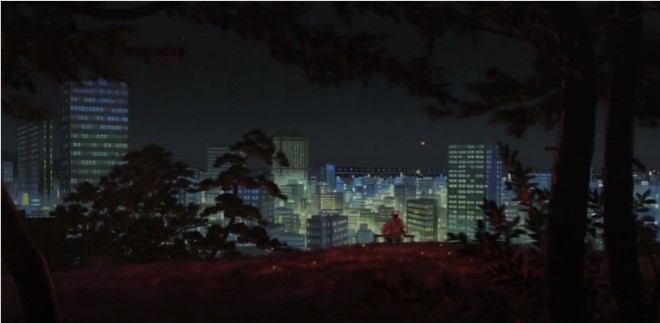In the first part of this two-part blog post, the chronological and the spirit timelines of Grave of the Fireflies were located and defined, with the aim of showcasing how Plantinga’s concept of the spillover effect is found and works within the film space. In this second part, two more sequences of Grave for the Fireflies will be used to showcase how the spirit timeline works to induce a spillover effect, and finally, how this effect provides fertile ground for an introspective evaluation of the events the film depicts.
That Tearful Sequence. After the death of little Setsuko, the spirit timeline shows us a sequence without dialogue, portraying the child playing alone with non-diegetic music in the background. Focusing mainly on Seita, the plot hid from us all those moments in Setsuko’s life, which now flash in front of our eyes like a bright stream of tears: her playing with a big sheet as a cape; her dressed up as a soldier; her making mud cakes. The innocence of this sequence, together with the outstanding visual performance, elicits immediate and desperate negative emotions. And once again, there is no transformation. The brutality of death, and the hopelessness that descended on the film space from the beginning onwards, linger on, even enhanced by the bright and vernal looks of the surroundings. The neorealist style of the narration does not force any kind of renewed meaning onto the audience. This accurate portrayal of life — which most of the time is crude and meaningless — makes our eyes water.
“Why do fireflies die so soon?”, asks Setsuko. The audience is left wondering the same thing. This montage becomes a silent eulogy. As we watch Seita keep vigil next to his sister’s pyre, a sparkle of fireflies tells us that this timeline has ended (see Figure 3).
Their story is over and there is no happy ending. At least not in this timeline. The circular narrative of Grave of the Fireflies brings us back to where we started: the field with the ghosts of Seita and Setsuko. Surrounded by fireflies, they quietly sit on a bench. Seita gives the Sakuma Drops tin back to Setsuko, who replies with a nod and a smile. As the shot grows wider, we see a modern version of the city of Kobe, illuminated and rich with skyscrapers. While Setsuko sleeps on his legs, Seita contemplates the city in silence (see Figure 4). The spirit timeline disregards a chronological depiction of events, but works as a timeless window, opened and shut throughout the story to show the audience those moments that were not included in the main plot, but had crucial symbolic importance within the story nonetheless.
Conclusion. From the two excerpts from Grave of the Fireflies here analyzed it emerges how the transformation of negative emotions into positive ones did not occur due to the placement of the first-mentioned excerpt at the beginning of the film. This prevented the audience from developing any kind of sympathetic feelings towards the protagonists. The ritual of commemoration, described and analyzed in the previous blog post, and embodied by Setsuko’s ashes treated as waste, evokes a sense of hopelessness that will linger on the entire film instead of creating a renewed sense of meaning.
In Grave of the Fireflies, this sense of meaning is rather subtle. The two protagonists die before the end of the main timeline, and there is no apparent resolution — that is why the feeling of hopelessness lingers on until the very end. When watching them contemplating the view, we do not feel relieved, nor do we develop an internal sudden epiphany. This sympathetic narrative finds its sense of meaning not in its tragic content, but in its lack of overt morale. The audience is free to reflect on the events without the aid of a hyper-coherent narration, but with the freedom of neorealist introspection.
The (true) story of the siblings is depicted as raw and brutal until the very end when, in pure Shintoist fashion, their spirits guard the town where they both lost their lives. Perhaps the true sense of meaning lies in the acknowledgment of the brutality of life. Grave of the Fireflies transforms its negative feelings into positive ones by helping the audience cope with the tragic nature of life in all its long, meaningless, but somehow valuable moments. Grave of the Fireflies leaves us wandering in the dark, with a path only illuminated by some fireflies.
Gaia Kriscak is a MA student at the Department of Film and Screen Media at UCC, Ireland. She is interested in the function and the portrayal of props and domestic space in world cinema.


